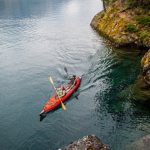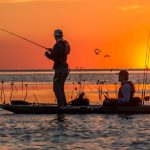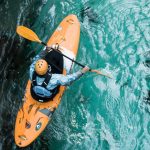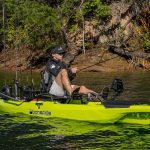Want an inflatable kayak that can take 2 persons on board? In this guide, we will walk you through what you should consider when choosing an inflatable tandem.
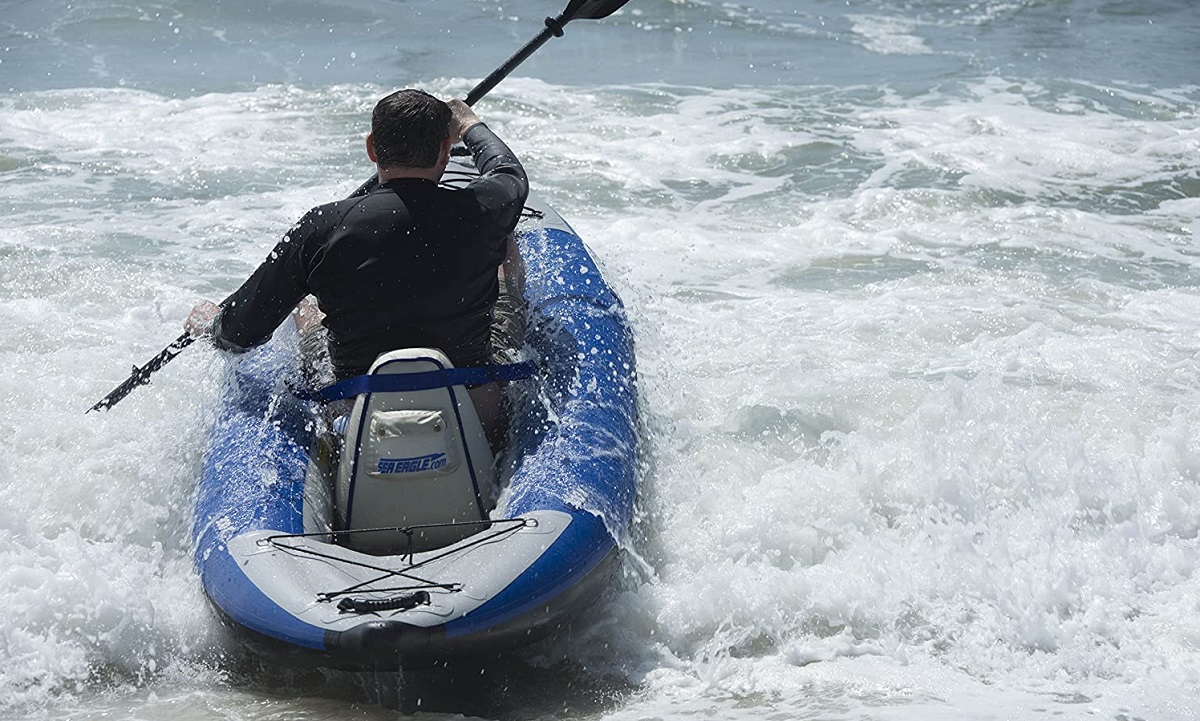
In a hurry? Our pick as the best all-purpose whitewater inflatable kayak is Sea Eagle Explorer 300X
Inflatable kayaks have taken hold of the market and are sticking around. A few years ago, we might have been a little cautious about this, but recent advances in inflatable technology have turned us from inflatable skeptics to enthusiasts.
The introduction of drop stitch technology and heavier-duty materials have made these kayaks capable in any environment, even white water.
So here’s our guide to inflatable whitewater kayaks.
As an affiliate of Amazon and other retailers, we may earn a small commission when you buy via our links, at no additional cost to you. Thank you!
At a Glance: Best Inflatable Whitewater Kayaks
Best All-Purpose Whitewater Inflatable Kayak: Sea Eagle Explorer 300X
Best Lightweight Whitewater Inflatable Kayak: Advanced Elements Attack Pro
Most Durable Whitewater Inflatable Kayak: Aire Outfitter I
Best Budget White Water Inflatable Kayak: NRS Star Outlaw I
Best Whitewater Packraft: Alpacka Valkyrie
Best Tandem Whitewater Inflatable Kayak: Aire Lynxx II
Best Affordable Tandem Whitewater Inflatable Kayak: Sea Eagle Explorer 380X
Comparison Table: Best Inflatable Whitewater Kayaks
| Model | Specs | Where To Buy |
 Sea Eagle Explorer 300X | Size: 9’10” x 39″ Weight: 30 lbs Capacity: 395 lbs | Amazon |
Advanced Elements Attack Pro | Size: 9’9″x 35″ Weight: 25.5 lbs Capacity: 225 lbs | Amazon |
 Aire Outfitter I | Size: 9’10” x 40″ Weight: 36 lbs Capacity: 400 lbs | Outdoorplay |
 NRS Star Outlaw I | Size: 9’10” x 38″ Weight: 30 lbs. Capacity: 275 lbs | Eco Fishing Shop |
 Alpacka Valkyrie | Size: 8’5″ x 32″ Weight: 12.9 lbs Capacity: 230 lbs | Alpacka Raft |
Aire Lynx II | Size: 12’6″x 39″ Weight: 43 lbs Capacity: 475 lbs | Amazon |
Sea Eagle Explorer 380X | Size: 12’5″ x 39″ Weight: 40 lbs Capacity: 750 lbs | Amazon |
Best Inflatable Whitewater KayakReviews
Best All-Purpose Whitewater Inflatable Kayak: Sea Eagle Explorer 300X
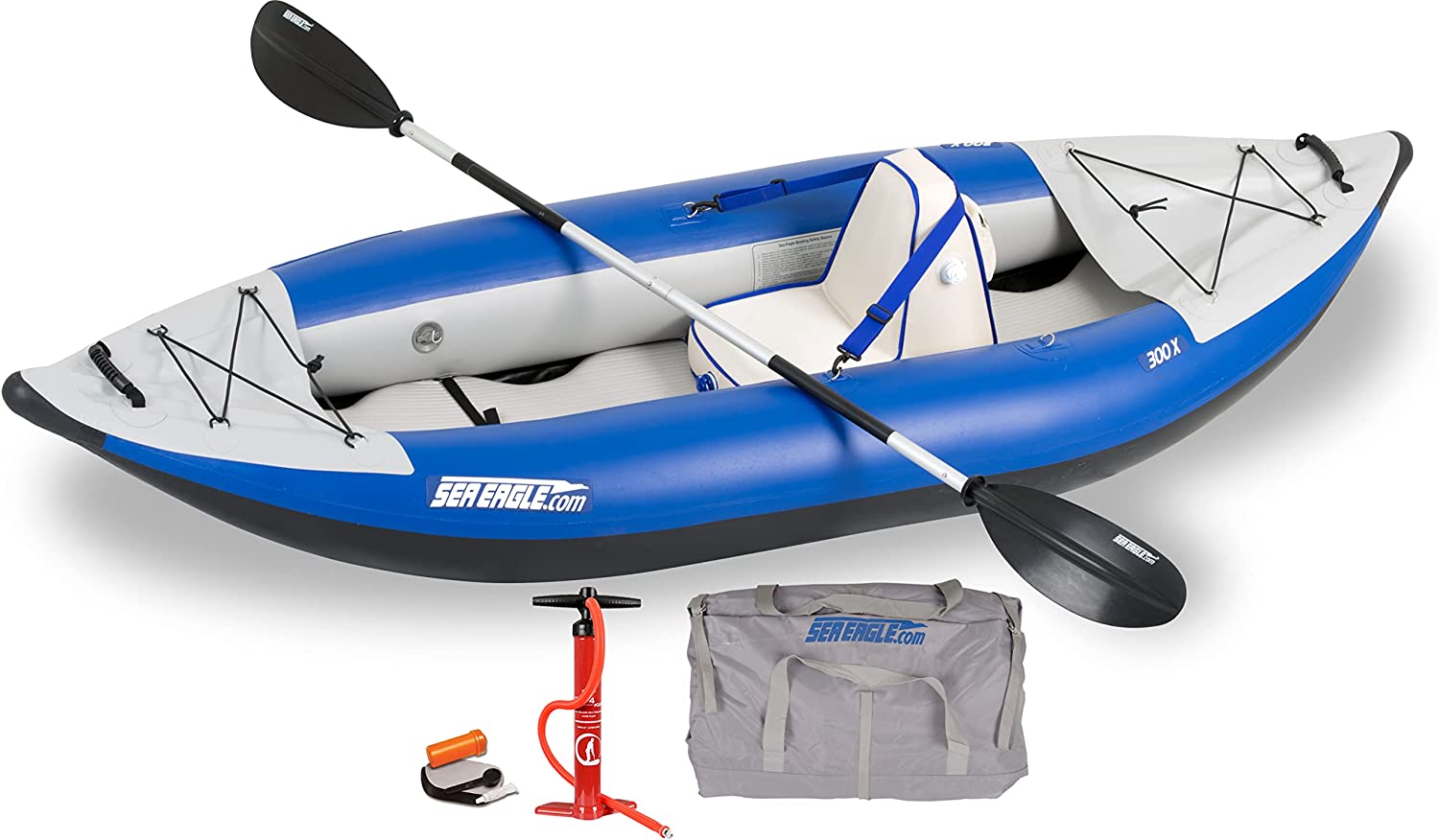
Length: 9 ft. 10 in. / 3 m
Width: 39 in. / 100 cm
Weight: 30 lbs. / 14 kg
Capacity: 395 lbs. (179 kg)
Sea Eagle Explorer range is designed to take on the toughest of trips, from the open ocean to white water rivers. The 300X has a flat hull for optimal clearance, as well as a sharp rocker at the bow and stern to kick over waves and ride dry.
The 1100 Decitex material gives the 300X a robust feel to it, so you won’t worry about bumping off rocks as you make your way downriver.

The Explorer 300 has 16 in-floor drainage holes to drain any water from the cockpit. This means that even if you crash through big waves, you empty fast and maintain full control of your kayak.
Internally, you get a high-backed seat fitted as standard. There are 18 D-rings throughout the kayak, so the Explorer series is fully customizable to suit your specific paddling style.
Pros:
- Heavy duty build
- Swept bag skeg for direction on the river
- Easy to control
- High-pressure floor for a rigid feel
Cons:
- No foot braces as standard
Best Lightweight Whitewater Inflatable Kayak: Advanced Elements Attack Pro
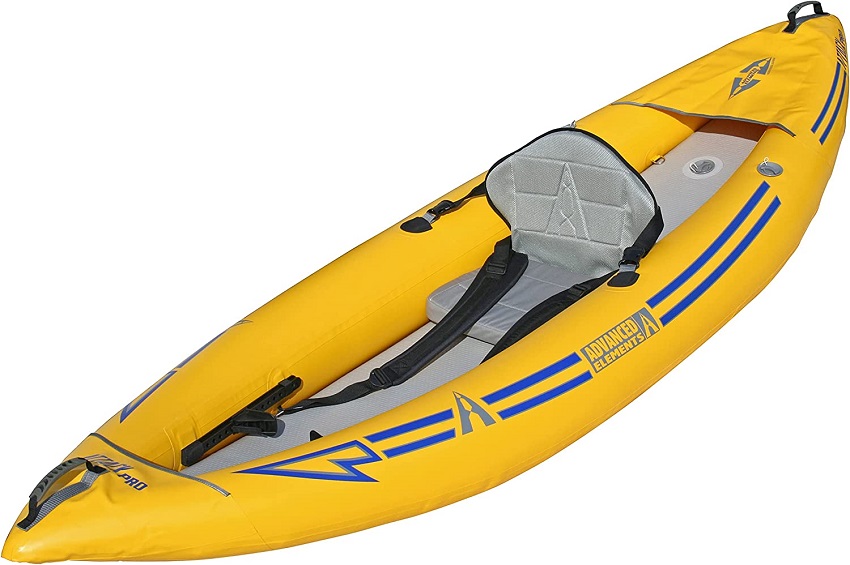
Length: 9 ft. 9 in. / 2.97 m
Width: 35 in. / 89 cm
Weight: 25.5 lbs. / 11.5 kg
Capacity: 225 lbs. / 102 kg
The drop stitch design of the Advanced Elements Attack Pro means its floor can be inflated to a higher pressure than some others on this list.
With higher pressure and rigidity comes increased performance, which comes close to that of a hard-shelled kayak.
Then there’s the hull shape. The Attack Pro is a wide, stable base for inspiring confidence, but comes with a healthy rocker at the front for crushing through waves.
That rocker keeps out most of the water, but for any that does get in, there are self-bailing ports fitted throughout.
As well as the high-backed seat inside the Attack Pro, there are fully adjustable footpegs and thigh straps. This means you get more control coming from your body, rather than the paddle, and the ability to progress your kayaking further.
Pros:
- Good level of outfitting
- High-pressure seams
- Lightweight enough for portages
Cons:
- Low capacity
Most Durable Whitewater Inflatable Kayak: Aire Outfitter I
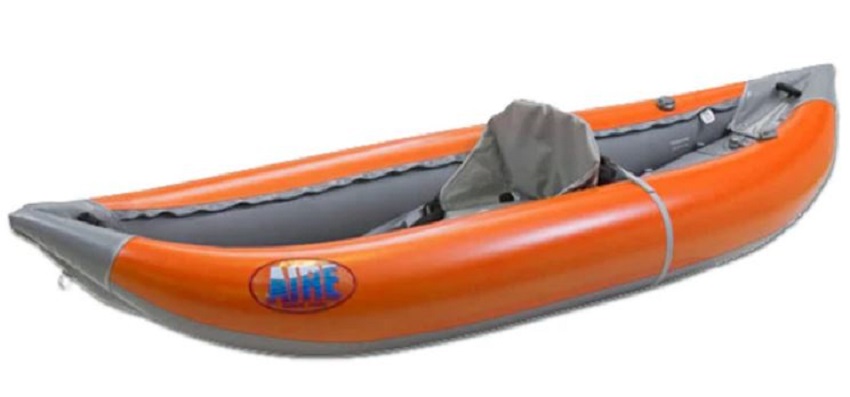
Length: 9 ft. 8 in. / 2.94 m
Width: 40 in. / 102 cm
Weight: 36 lbs. / 16.3 kg
Capacity: 400 lbs. / 181 kg
If you’re looking for a burly whitewater inflatable kayak that can take a beating, the Aire Outfitter I is a great choice.
This kayak is suitable for beginners looking for the security of a stable boat, but also for experienced paddlers who want to push through bigger rapids. This also makes it a great boat if you’re looking to progress your river kayaking.
The comfortable internal seat keeps you upright and engaged. The big diameter tubes can make it slightly more challenging for smaller framed paddlers, but the lower center of gravity helps to keep you even more stable.

At the bow, this kayak has a healthy amount of rocker. It’s enough to ride high without making the kayak difficult to keep on the right line through rapids.
Pros:
- Stable and confidence-inspiring
- Good for beginners and more experienced kayakers
- Heavy duty design
Cons:
- Large diameter tubes can make it harder for smaller framed kayakers
Best Budget White Water Inflatable Kayak: NRS Star Outlaw I
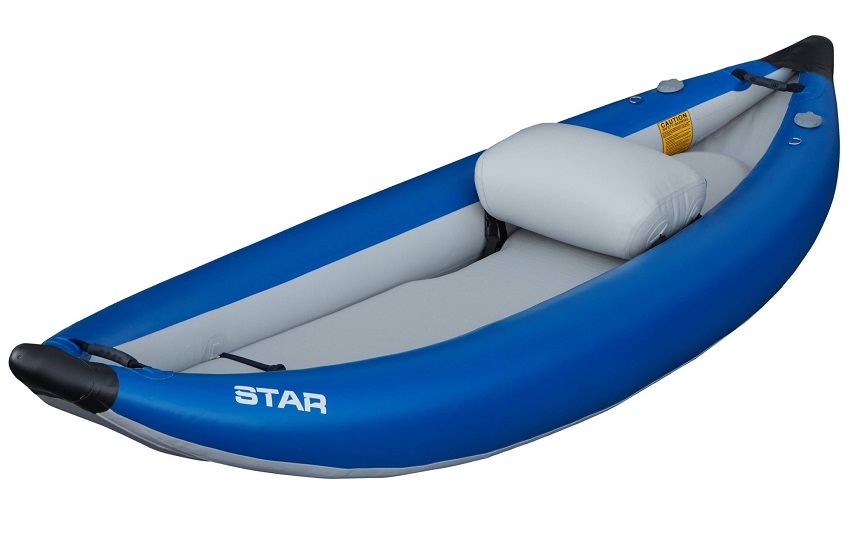
Length: 9 ft. 10 in. / 3 m
Width: 38 in. / 97 cm.
Weight: 30 lbs. / 13.5 kg
Capacity: 275 lbs. / 125 kg
NRS Star Outlaw I is a budget-friendly, heavy-duty white water inflatable from a company that knows a thing or two about PVC.
NRS has a history of making rafts, tubes, and any other inflatables you can think of for kayak schools and rafting centers around the world. The Outlaw I may be simplistic in design, but it’s robust and reliable on the water.
The Star Outlaw I has a drop-stitched floor that can be inflated to higher pressures. This gives you a more rigid feel to the kayak, resulting in better control and increased stability.

The inflatable backrest pad keeps things simple inside, and though this kayak may lack outfitting, it’s comfortable and straightforward to inflate, deflate, and paddle.
Pros:
- Budget-friendly
- Simple and easy to use
- Durable
Cons:
- Lacks outfitting
Best Whitewater Packraft: Alpacka Valkyrie
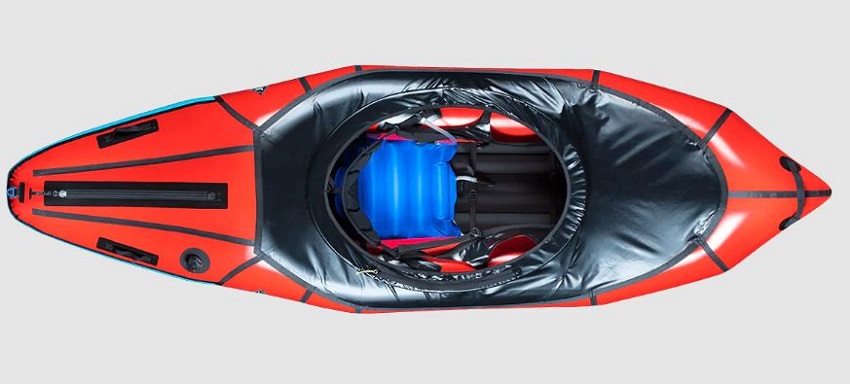
Length: 8 ft. 5 in. / 2.58 m
Width: 32 in. / 81 cm
Weight: 12.9 lbs. / 5.9 kg
Capacity: 230 lbs. + / 104 kg +
In the world of packrafts, it’s hard to look beyond Alpacka. This company is renowned for making many of the best packrafts in the world, and the Valkyrie is no exception.
The Valkyrie is inspired by modern creek kayak design, with a planing hull, pronounced rocker profile, and closed cockpit design. You get stability and directional control on the water, and a raft that fits into a small pack off the water.
Even better, though, is that you can get a fully dry ride in the Valkyrie. The rigid coaming around the cockpit lets you fit a spray skirt, so you won’t have to worry about waves and spray coming onboard.

Packrafts are designed with tripping and exploring in mind, and the lightweight design does have a price tag associated with that. However, their popularity is rising in more mainstream kayaking, with the lightweight package making it easy for anyone to carry the Valkyrie to the water.
Pros:
- Extremely lightweight
- Traditional kayak design
- Can fit a spray skirt
Cons:
- Price tag
- Overkill for many recreational kayakers
Best Tandem Whitewater Inflatable Kayak: Aire Lynx II
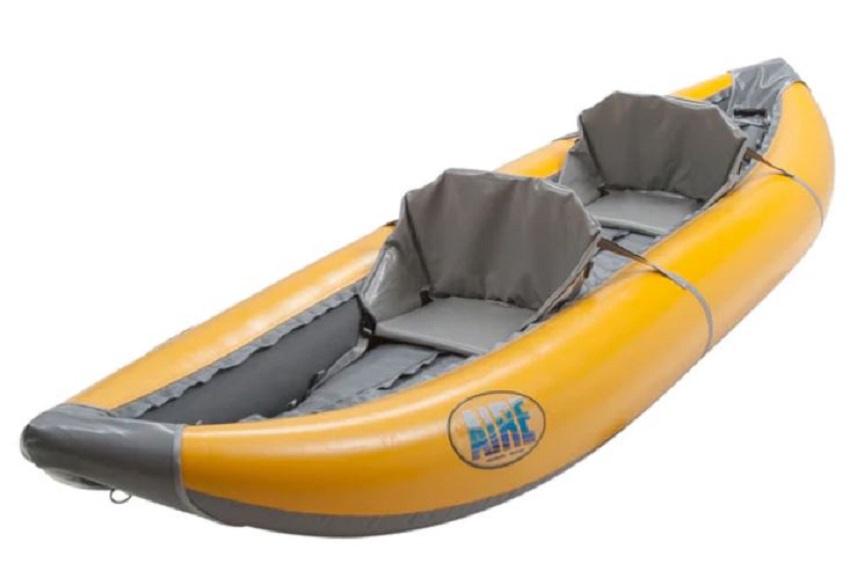
Length: 12 ft. 6 in. / 3.81 m
Width: 39 in. / 99 cm
Weight: 43 lbs. / 19.5 kg
Capacity: 475 lbs. / 215 kg
The Aire Lynx II is a sleek tandem whitewater kayak so you can hit up the river with your partner. Alternatively, if you want a solo day on the water loaded up with all your gear, the Lynx II can be paddled solo.
This kayak has a long flat hull that allows it to carry speed over the water. Couple this with the rocker profile and you’ve got a kayak for long days on the water in big waves and chutes.

One of the key selling points of the Aire Lynx II is the low-profile side tubes. Many tandem whitewater kayaks are fitted with large tubes for stability, but this can make it harder for smaller framed kayakers to reach the water.
Pros:
- Low-profile side tubes
- Sleek and stable profile
- Can be paddled tandem or solo
Cons:
- High price tag
Best Affordable Tandem Whitewater Inflatable Kayak: Sea Eagle Explorer 380X
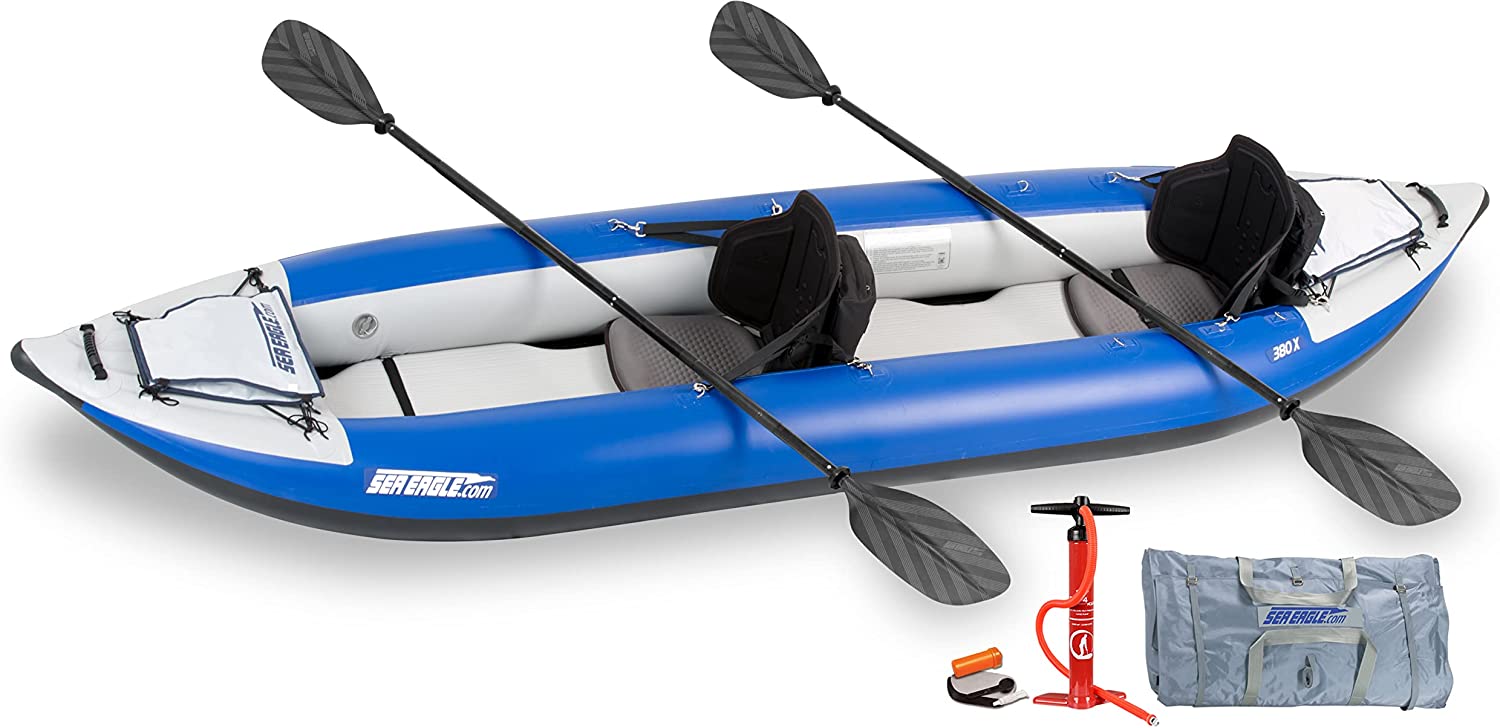
Length: 12 ft. 5 in. / 3.8 m
Width: 39 in. / 99 cm
Weight: 40 lbs. / 18 kg
Capacity: 750 lbs. / 340 kg
The Sea Eagle Explorer 380X is the tandem version of the popular 300X. Although this kayak is rated to take three paddlers, it performs better and is more comfortable with two kayakers.
The Sea Eagle Explorer series is made from tough 1100 Decitex, designed to withstand the use and abuse of whitewater kayaking.

A combination of a broad, flat hull and a high-pressure floor gives the Explorer 380X a high level of stability, perfect for beginners or those looking to push their boundaries. All this and Sea Eagle has managed to keep the tubes low-profile enough for even the smallest framed kayakers.
A swept-back fin at the rear of the 380X helps to keep your kayak on the right line as you cruise downriver.
Pros:
- Affordable tandem kayak
- High-pressure floor for stability
- Large capacity
Cons:
- Limited outfitting
Are Inflatable Kayaks Suited to Whitewater?
In short, yes. But there’s a little more to it than that.
Inflatable kayaks are most commonly used on whitewater rivers to give people an experience of running rapids without being in a closed-cockpit kayak.
The flat hull and the fact that they ride higher over the rapids also make them a beginner-friendly option.
But inflatable kayaks aren’t just there for beginners. They can be great for exploration and learning to paddle whitewater, too.
They do have their limitations though. If you’re serious about progressing your river skills, you can reach these limits quite quickly and need to move to a hard-shelled white water kayak.
Inflatable white water kayaks are often preferred by occasional river kayakers or paddlers who have limited storage or transport options.
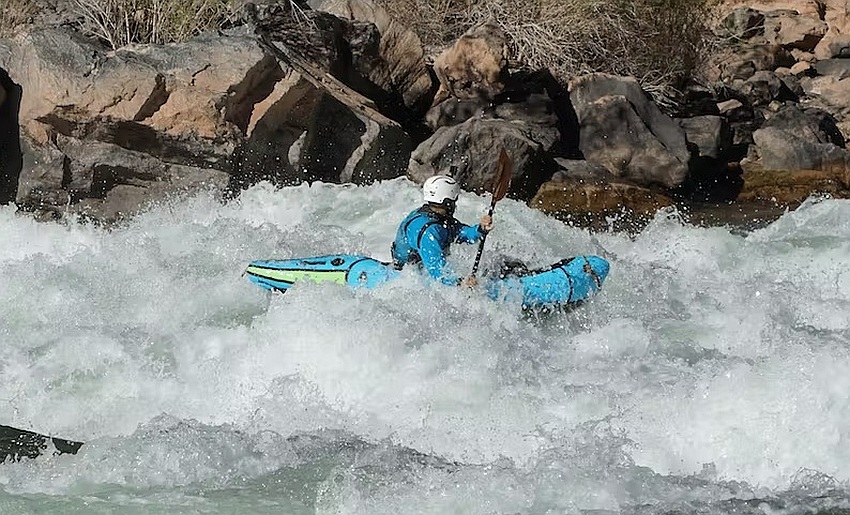
Are Inflatable Kayaks Safe for Whitewater?
Inflatable kayaks are safe to use in whitewater, so long as you are aware of their limitations.
These kayaks are easy to enter and exit and are usually highly stable, too.
But there are some things to remember when paddling an inflatable kayak in white water:
Beware of strong rapids
An inflatable kayak, no matter how firm it may feel, will not have the same rigidity as a hard-shelled kayak. This means that higher volume rapids or drops may fold the kayak and this can make it harder to control and potentially prone to flipping.
Beware of sharp rocks
Inflatable kayaks may be punctured if they are hit against sharp rocks, or continually scraped down the river. Most inflatables have multiple chambers, so you shouldn’t sink if you puncture your kayak, but it will become harder to paddle and you should hit the shore to fix your kayak.
Paddle to your skill level
Inflatable kayaks also often lack the safety features fitted to a hard-shelled kayak, like step-out pillars or strong points to unpin them.
You should always paddle a kayak within your capabilities and control. Inflatable kayaks are generally not recommended on rivers above Class III.
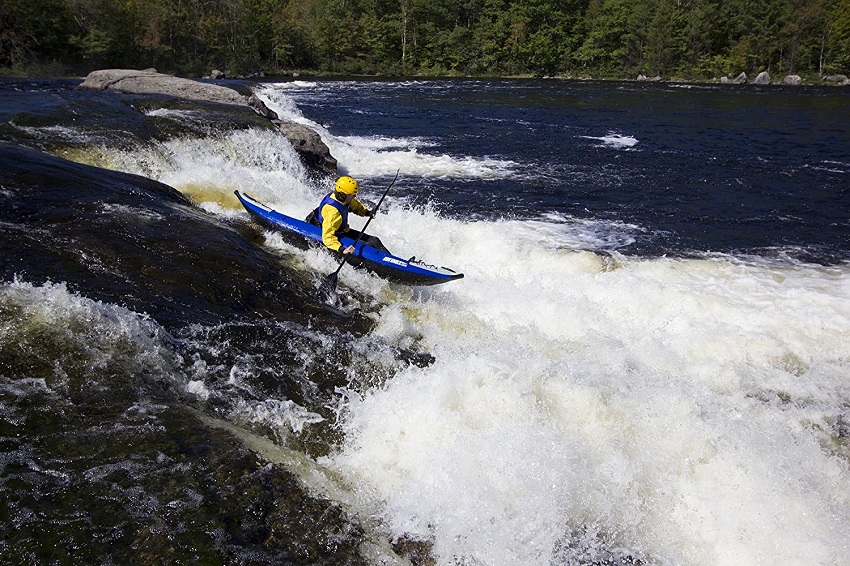
How to Pick an Inflatable Kayak for Whitewater
Durability
Whitewater rivers are rough places. From rocks and riverbanks to waves and water, a lot of forces are working on your kayak. You need a kayak that can withstand these.
The materials and the build quality of your inflatable kayak will both have an impact on how durable your kayak is.
Heavier denier materials will withstand abrasions and impacts better than thinner alternatives. Equally, reinforced sections of the hull can help to reduce the likelihood that you deflate mid-flow.
Heavier duty kayaks tend to mean more weight and often a higher price tag though. Unless you’re running rocky creeks, you can often get away with a slightly lighter-weight kayak by avoiding the rocks as you go.
Self-bailing Floor
The last thing you want when you’re paddling a river is to be in a kayak that is filling up around you.
It’s inevitable that waves will crash over the bow and sides of your whitewater inflatable kayak. But if you fill up with water, you’re not only getting soaked, but your kayak becomes almost impossible to control.
Your whitewater kayak should be fitted with self-bailing scupper holes in the hull. It might seem like a design flaw to have holes in the floor of your kayak, but thanks to the inflatable design your kayak sits high enough out of the water that you aren’t about to sink.
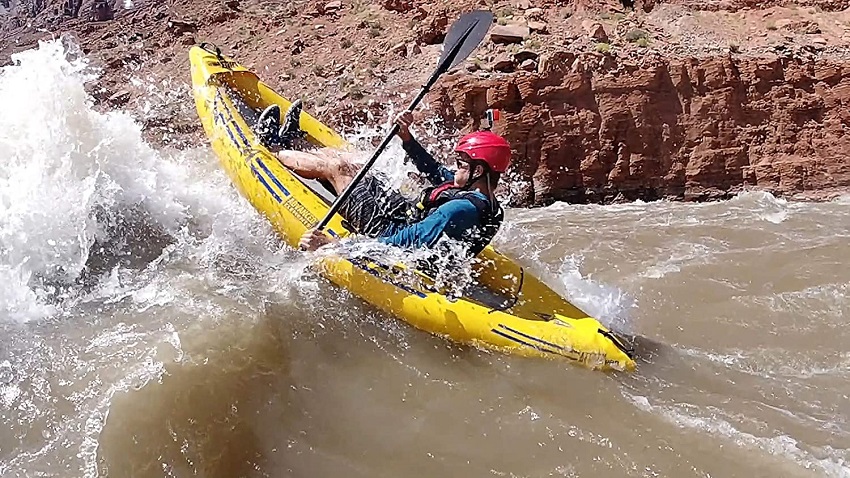
Capacity
All kayaks come with a stated capacity. This is the upper limit to how much weight your kayak can hold before it submerges.
But that doesn’t mean you can load it within a few pounds of this weight and it will still perform.
A good rule is that you should avoid loading more than 70% of the capacity. That way you stay within the optimal weight range for performance and are going to have far greater control over your kayak.
Features
The performance of your kayak is down to the size and hull shape, but also the features it is fitted with.
Features like a raised seat, a backrest, thigh straps, and footpegs, will all give you greater control in your kayak. If you have none of these then you are fully dependent on the paddle to do all the work instead.
Other features may be more safety oriented. For example, multiple air chambers mean that a puncture won’t see you sinking into the water and let you paddle to the edge of the river.
Look for a kayak with features that fit your kayaking aspirations. If you are heading out for a short cruise, a more budget option may be appropriate. If you’re planning on kayaking on the river every weekend you may be more inclined to stretch the budget to a more feature-laden inflatable kayak.
Pack Size
If there’s one key appeal to an inflatable kayak then it must be how easy they are to transport and store.
The main reason many people opt for an inflatable rather than a hard-shelled kayak is that they don’t have the space at home to store a large kayak, or to transport one in their vehicle.
But not all inflatable kayaks are the same size. Before you buy what should be your perfect kayak, double-check the pack size and ensure that it fits in the trunk of your car or in that cupboard.

